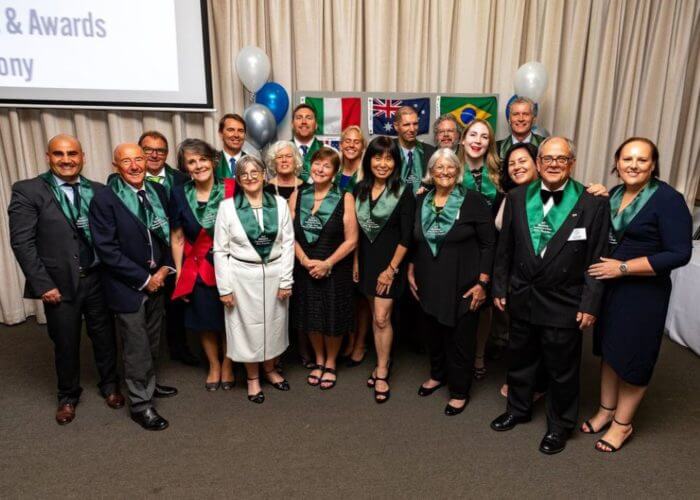A Guide to Swimming Halls of Fame: Where History Is Celebrated

A Guide to Swimming Halls of Fame: Where History Is Celebrated
This article will provide an overview of swimming Halls of Fame (international, national and local), the various disciplines that are celebrated, their purpose, how they operate, how to start one and a look at general Halls of Fame that includes swimmers.
The International Swimming Hall of Fame (ISHOF) provides a top-level arch over the sport. Annual classes of honorees/inductees date to 1965 and the disciplines include swimming, water polo, artistic swimming, diving and the recently added Paralympics. The vision/purpose includes: To be the global focal point for recording and sharing the history of aquatics, promoting swimming as an essential life skill, and developing educational programs and events related to water sport and to be the official repository for aquatic history.
In addition to swimmers from the pool, ISHOF also include pioneers, open-water swimmers, coaches and contributors.
Under the umbrella of ISHOF are two other Halls of Fame, albeit with large degrees of independence.

Photo Courtesy: Ned Denison
The International Marathon Swimming Hall of Fame (IMSHOF) covers open water (10k and beyond) and is dedicated to promoting the athletes, coaches, administrators, pilots, reporters, volunteers, organizations, race directors and associations affiliated with marathon swimming. It is an online, virtual shrine that is dedicated to history, memory and recognition. The IMSHOF has named classes dating back to 1963. It is interesting that both ISHOF and IMSHOF named Gertrude Ederle (the first woman to swim the English Channel) in their inaugural classes. IMSHOF also has categories for organizations and pilots, as there is more of a focus on specific geographic swims like the English Channel.
The Masters International Swimming Hall of Fame (MISHOF) started naming classes in 2003 with a goal of inspiring every adult to live an active and healthy lifestyle through swimming. This mantra is in line with the focus on events for those ages 25 and older. This HOF includes swimmers such as Rowdy Gaines, who is also an ISHOF honoree.
All three of these Halls of Fame widely seek nominations. They screen (against achievement and ethics criteria) and have appointed annual voting panels. Selections are announced with fanfare and induction ceremonies are held annually, with sashes and certificates presented. The various websites are updated and engravings are done on plates at ISHOF’s museum in Fort Lauderdale, Florida.
A new created Hall of Fame – International Ice Swimming
This HOF focuses on swimming in much colder water and named classes starting in 2019. It also has a category for events, such as the 66 swimmers who relayed for more than six days across the Bering Strait. The voting panel consists of all individual honorees. This Hall was started by a group of experienced ice swimmers and contributors who served as the initial voting panel and agreed NOT to be nominated in the first years. This approach avoided a common criticism that the creators of Halls all vote themselves in – and, hence, hinder wide acceptance.
Country, State and Local Swimming Halls of Fame
These Halls generally honor citizens of the location. A few examples are given below (there are many more).
Country
Swim England Hall of Fame; Swimming Canada’s Circle of Excellence; Australia Marathon Swimming Hall of Fame; and Ireland Marathon Swimming Hall of Fame.
State/Province
Hawaii Swimming Hall of Fame; Swim Ontario Hall of Fame; Solo Swims of Ontario Hall of Fame; and Vermont Open Water Swimming Hall of Fame.
More General or Non-Swimming Specific Halls of Fame
Swimmers and contributors have been honored in hundreds of other Halls of Fame. Some are based on location and others focus on members of a specific group, such as Paralympians. Here are some examples:
International
Paralympic Hall of Fame; International Women’s Sports Hall of Fame; International Jewish Sports Hall of Fame; Africa Sport Hall of Fame; and Caribbean Hall of Fame
Country
Slovenian Athletes Hall of Fame; Korean Sports Hall of Fame; Singapore Sports Hall of Fame; Sport Australia Hall of Fame; Canadian Sports Hall of Fame; Hall of Fame of Finnish Sport; Black American Hall of Fame; Italian American Sports Hall of Fame; American Indian Athletic Hall of Fame; and USA Amateur Sports Hall of Fame.
State/Province
Western Australian Hall of Champions; New Jersey Hall of Fame; and Michigan Sports Hall of Fame
City/Region
New York City Sports Hall of Fame and Museum; West Orange (New Jersey) Hall of Fame; Pacifica (California) Sports Hall of Fame; and Cambridge Sports Hall of Fame.
Club
Grantham Swim Club (England) Hall of Fame
Universities/Secondary Schools
Temple University Athletic Hall of Fame; and Cardinal Mooney Hall of Fame (Ohio High School)
Voting Panels, Visibility and Criteria
There are no correct or best practices. Most Halls rely on a panel to vote on a choice of nominees. These panels are most often appointed by the Hall’s leadership team and provide geographic, role and era representation. Other panels are comprised of all honorees. Interestingly, the members of the Baseball Writers Association of America select the members of the Baseball Hall of Fame.
Some Halls make the names of voters and nominees, plus the number of votes, public. Most keep parts of this process private. Each method has advantages and disadvantages. Public disclosure of vote tallies is great to remove any “questions” about the process, but not very uplifting for the nominee with the lowest totals. Lobbying campaigns directed at voters can generate some great publicity for that Hall, but it can corrupt the vote and perhaps skew the vote away from historic records. Some Halls require a certain number (or percentage) of votes and others take the top vote getters.
It is generally not simple to apply rigid criteria to selection. Halls with a wide scope (example: International Women’s Sports Hall of Fame) have very different nominees (perhaps a gymnast with an Olympic Silver medal and a swimmer with a World Championships Gold medal), so it is impossible to directly compare athletes. The Halls with a narrow focus, for example a University Swimming Hall of Fame, might decide that any swimmer achieving “All-American” status would be automatically inducted.
Money
The Halls need to balance their offerings with the requirement to fund the activities. Some Halls are virtual. They celebrate through press releases, a Facebook page, website and a small physical museum inside a larger facility, with no annual gatherings. The above can be accomplished with no cash budget and just volunteer help. The Vermont Open Water Swimming Hall of Fame is a good example. It maintains a page on Openwaterpedia. Conversely, running a dedicated facility with staff and sponsoring attendance tickets for new inductees and their close family members requires annual budgets of several hundred thousand dollars (and up).
Older Eras and Diversity
There are often issues with nominees from past eras. Memories can be faint and the rules of the sport may have changed. Technology, ease of travel, nutrition and coaching often minimize their achievements. Another challenge is that some sports were dominated by white men in the early decades. ISHOF has set out criteria: Deceased persons should only be considered if there is a compelling reason that will ensure significant representation at the ceremony. It has a Pioneer category to honor these individuals and other special circumstances, such as those affected by interruptions caused by war or politics, barrier-breaking moments, societal changing events, etc. ISHOF also recently introduced a Paralympian category.
Finally
Done well, starting a new local Swimming Hall of Fame can be a positive experience for all involved. It reaches out to the stars of yesterday, emphasizes the importance of contributors, provides a good news story annually, reunites old friends and preserves history. If you would like advice in setting up a new Hall of Fame, please contact ned.denison@corkopenwater.com, who has been through the process with four new Halls in the last few years and is the Chairperson of IMSHOF.



